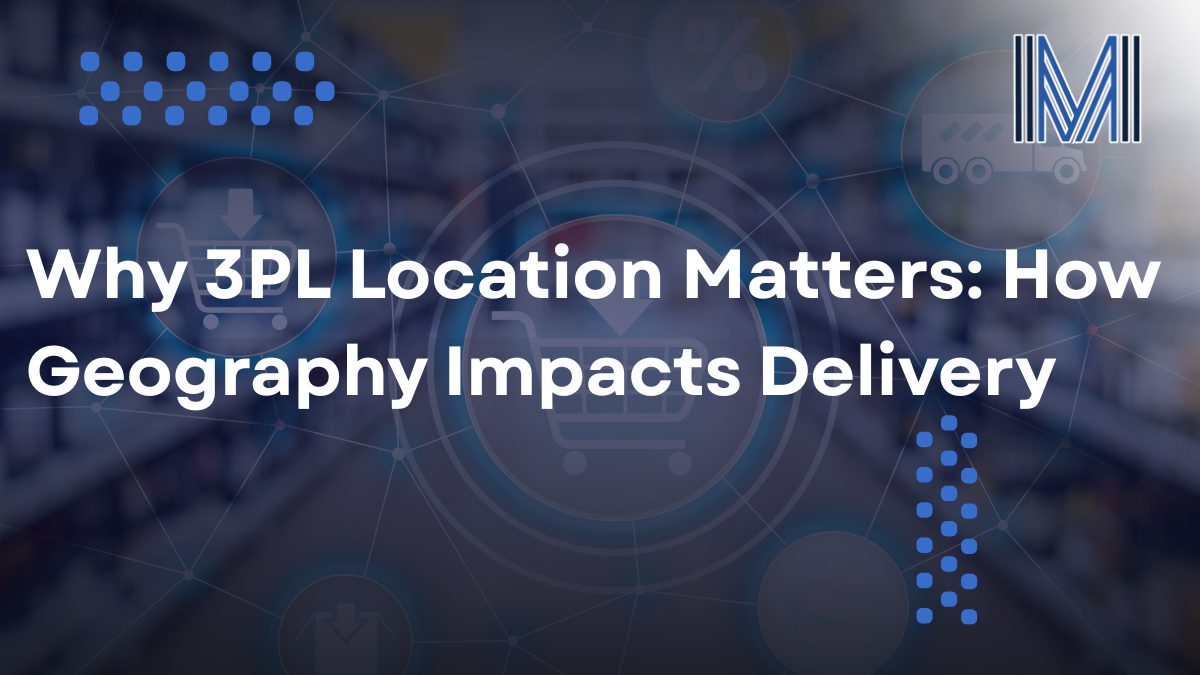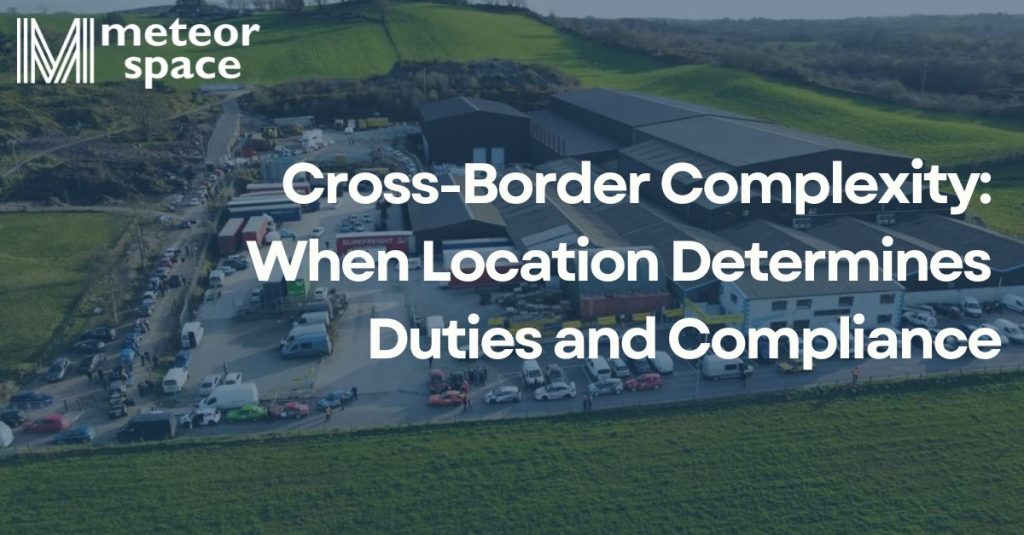14 Nov

When brands evaluate potential fulfilment partners, they tend to gravitate toward the obvious questions: How advanced is the WMS? What are the storage fees? Do they integrate with my ecommerce platform? These are important considerations, but they only tell part of the story. One of the most influential factors, and one of the least discussed, is the physical location of the 3PL itself.
Where your inventory sits on the map has a direct, measurable impact on delivery performance, duty charges, lead times, and customer satisfaction. In many cases, location determines whether your fulfilment strategy becomes a competitive advantage… or a constant logistical headache.
In this article, we explore why 3PL geography matters more than most brands realise, how it affects every stage of the fulfilment journey, and why locations like Northern Ireland are becoming uniquely valuable in today’s cross-border ecommerce landscape.
Delivery Speed Begins Long Before the Order Ships
Delivery speed is often assumed to be a carrier issue, but in reality, the foundation is laid by geography, specifically, how well a fulfilment centre is connected to transport networks. It’s not about being located in a major city; it’s about having efficient access to the routes that matter.
A fulfilment centre positioned near strong motorway links, ports, airports, and courier hubs can move parcels quickly into the appropriate delivery channels. This allows orders to spend less time in long-distance transit and more time within the reliable, local courier networks that support fast and predictable delivery times. In regions like the UK and Ireland, being close to these transport corridors often makes next-day delivery possible without relying heavily on premium services.
Connectivity also influences cut-off times. Warehouses with easy access to primary road networks and courier depots can process orders later in the day and still make dispatch deadlines. This extra flexibility can significantly increase daily order capacity and improve customer satisfaction.
In contrast, fulfilment centres that lack efficient transport connections, regardless of whether they are urban or rural, may face earlier dispatch cut-offs and longer initial transit routes. These delays aren’t the result of poor warehouse operations but simply the geographical limitations of being further from essential courier touchpoints.

Cross-Border Complexity: When Location Determines Duties and Compliance
In a global ecommerce environment, very few brands sell exclusively within one country. This means cross-border logistics, and the associated taxes, duties, and customs checks, are unavoidable. The location of your fulfilment centre plays a critical role in determining how smooth or complicated this process becomes.
Shipping from mainland UK into the EU, for instance, involves customs declarations, duty assessments, VAT adjustments, and potential clearance delays. Even when shipments move quickly, this administrative layer adds friction and uncertainty.
Customers may also face unexpected import charges upon delivery, which is one of the fastest ways to undermine trust and increase returns.
This is where Northern Ireland holds a rare and strategic advantage because of its post-Brexit regulatory framework. Goods fulfilled from Northern Ireland can move into Great Britain and also into the EU single market without the usual customs barriers that mainland UK warehouses encounter. It is one of the only fulfilment locations in Europe that enjoys this dual-market position.
For brands shipping to both UK and EU customers, this dual access significantly reduces administrative burdens, eliminates unexpected duty costs, and preserves faster delivery times, especially for Ireland and western European markets. This makes Northern Ireland not just a geographically central location… but a regulatory gateway.
Carrier Reliability and Delivery Success Rates Improve with Strategic Positioning
Most customers never think about how many distribution centres, hubs, and carrier depots a parcel passes through. But every handoff increases the risk of delay or damage. Geography dictates how many of these handoffs occur.
Fulfilment centres positioned near dense courier networks allow parcels to stay longer within local routes rather than travelling through multiple regional sorting centres. This drastically reduces mishandling, first-attempt delivery failures, and routing errors. In the UK and Ireland, regions with strong courier infrastructure have statistically better on-time delivery rates, meaning a 3PL’s location is directly tied to customer experience.
Additionally, shipping from a location with ease of access to ports and airports provides more reliable international outbound services. Parcels can reach international hubs faster, undergo clearance sooner, and enter foreign delivery networks with fewer delays. A geographically isolated warehouse simply cannot match these efficiencies.

Returns Processing and Reverse Logistics Are Location Dependent
Returns are an unavoidable part of ecommerce, especially in sectors such as fashion, fitness, apparel, and consumer electronics. Faster return processing leads to quicker refunds, improved customer satisfaction, and faster restocking, but only if the returns travel efficiently.
If a fulfilment centre is centrally located or well connected, incoming returns can be processed quickly with minimal transit time. If the warehouse is far from primary customer regions, reverse logistics become slower, more expensive, and more complex. Brands may find their inventory sitting in transit limbo rather than being inspected, restocked, or resold.
This is particularly relevant for brands operating in both the UK and EU. Having a strategically positioned fulfilment centre that supports returns in both directions minimises delays and protects revenue from being tied up in returned stock.
When Choosing a 3PL, Start with the Map
Technology, pricing, automation, reporting dashboards, and customer service all matter, but none of these elements can compensate for a fulfilment centre that is geographically disadvantaged. Location influences speed, affordability, compliance, customer experience, and scalability.
For brands selling into multiple markets, especially those targeting both the UK and EU, positioning inventory in the right region can dramatically streamline operations and reduce costs. That’s why areas like Northern Ireland are becoming fulfilment hotspots for brands that want speed, flexibility, and borderless access.
A 3PL’s location isn’t just a logistical detail. It’s a strategic decision that can define the success of your entire ecommerce operation.
Author:
Holly McWilliams
Holly McWilliams is a Marketing Executive at Meteor Space, specialising in content creation and digital strategy for ecommerce and fulfilment solutions. She focuses on developing engaging, SEO-driven content that highlights industry insights and showcases how Meteor Space supports brands with scalable logistics.
UPDATED ON: 27/08/2025
FAQs
Why does a 3PL’s location affect delivery speed?
A 3PL’s location determines how quickly parcels can enter major courier networks. Warehouses closer to strong transport routes, such as motorways, ports, airports, and carrier hubs, can dispatch orders faster and reduce long-distance transit time, which leads to quicker, more reliable deliveries.
Why does cross-border location matter post-Brexit?
Post-Brexit, goods moving between the UK and EU are subject to customs checks, duties, and paperwork. A 3PL’s location determines whether brands face these barriers or avoid them. Some regions, such as Northern Ireland, offer unique advantages that minimise cross-border friction.
Why is Northern Ireland considered a strategic fulfilment location?
Northern Ireland allows qualifying goods to move into both the UK and the EU Single Market without many of the customs complications seen elsewhere in the UK. This dual-market access supports faster delivery, lower duty costs, and frictionless cross-border fulfilment.
Can a 3PL’s location improve customer satisfaction?
Absolutely. Customers care about fast and predictable delivery. A well-positioned 3PL supports accurate delivery promises, reduces delays, avoids customs issues, and helps ensure a smoother post-purchase experience.



